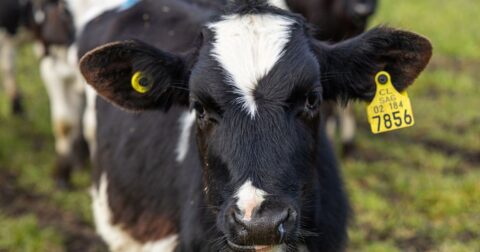Is New York City Getting its Composting Program Right?
Climate•10 min read
News
Unfortunately, it’s not that simple.


Words by Dawn Attride
Last Friday, Congress heard from several speakers on the urgency of clamping down on methane, an extremely potent greenhouse gas that primarily comes from agriculture. Atmospheric methane levels have jumped 30 percent since the Industrial Revolution, largely due to human activities. The main solution proposed at the Congressional briefing was anaerobic digesters, otherwise known as dairy digesters, which convert organic or animal waste into natural gas and are increasingly gaining interest from both the agricultural and energy industry.
California Congressman, Jim Costa, among others, hailed the technology as economically sound and a “win” for reducing methane. While these digesters somewhat address the problem of emissions from animal manure specifically, they don’t address the largest issue of enteric methane –– a natural byproduct of cow digestion which is responsible for over 70 percent of agricultural methane emissions.
Researchers at World Resources Institute say the average American can cut their environmental footprint in half by reducing their dairy and meat consumption, thus reducing their diet-related land use and greenhouse gas emissions.
Dairy digesters work by breaking down animal waste and manure into biogas to be used for energy. In a sealed environment free of oxygen, bacteria degrade organic matter in the manure, producing various compounds and gasses that can be converted to natural gas. Livestock manure is responsible for roughly 14 percent of agriculture’s total greenhouse emissions in the U.S.
“Reducing methane is the single fastest way to slow down [global] warming,” Ilissa Ocko, Senior Advisor for the United States Special Presidential Envoy for Climate, told the audience at the briefing. Ocko called the methane problem “largely solvable” with the use of various emission-cutting technologies such as dairy digesters, but added that agriculture is a “large” and “very complicated piece of the puzzle.”
The Global Methane Pledge launched in 2021 by the U.S. and European Union — which now has 158 participating countries — plans to cut methane 30 percent by 2030 globally, relative to 2020. To do this, Ocko and other speakers urged for timely investment and implementation of policy and technology into methane abatement solutions.
Energy Vision, a New York-based environmental research group, hosted the briefing and spoke about the large-scale financial investment needed to curb methane emissions. Based on data from the Environmental Protection Agency and the Department of Agriculture, the group found “opportunity to deploy close to 5000 new digester systems across the country” which would “get us about 14 percent of the way to the 30 percent of the 2030 goal,” said Matt Tomich, President of Energy Vision. That would require close to $75 billion in capital, which Tomich says the private sector is “lining up to deploy.”
California is the leading dairy producer in the United States with approximately 1.7 million cows and over 1,300 dairy farms that contribute up to $10.4 billion to the state’s economy. This production is responsible for over half of California’s methane emissions.
At the hearing, Jim Costa, Congressman for California’s 21st district, hailed dairy digesters as a solution, with 238 digester facilities planned, and 129 facilities currently in operation in California. “[Many] dairies now in California have some form of digesters and sometimes dairies that are adjacent to one another partner in digester facilities because it makes sense. And it’s good economics and it helps reduce your waste stream, besides controlling the methane. So it’s a win, win, win,” Costa said.
He also mentioned a bipartisan bill introduced in 2023 called the Converting our Waste Sustainability Act (COWS), which will grant funding to alternative manure management systems for dairy and livestock producers to “reduce greenhouse gas emissions and improve air and water quality.” By investing federal tax credits, Costa said “methane digesters” can be adopted around the country to convert animal waste into natural gas and support the conversion of biogas into energy, adding that digesters can be linked up to gas fuel cells for further “efficiency.”
However, in California, CalBio, a biodigester company, has linked up with Bloom Energy, a fuel cell company that has had significant financial trouble in the past, such as blowing through billions for technology that has been challenged over the efficacy of their “clean” fuel cells.
The energy harnessed from cow manure is already used in a very real way, Kevin Abernathy, general manager of the Milk Producers Council, said. He spoke about his involvement in California’s first hydrogen fueling station from “cow power,” or manure, and his plans for developing a “cow powered hydrogen highway.” Abernathy added that so far, 2.4 million metric tons of CO2 equivalent had been collected from California dairy farms, powering 15,000 vehicles a day.
While dairy digesters and manure management appear to be an effective methane reduction pathway, they contribute nothing to dairy’s biggest methane problem: cow belches, otherwise known as enteric methane.
When asked by Sentient, Ocko agreed these technologies do little to prevent the bulk of livestock methane emissions coming from enteric fermentation. She noted that more research is needed, citing “exciting” solutions such as selective breeding and adding supplements to cows’ diet to reduce their methane output.
Other concerns with dairy digesters that were briefly mentioned at the hearing were pipeline transport and accessibility. Ocko noted that this natural gas is still methane which can escape into the atmosphere if pipeline transport and scaling isn’t carefully planned. “[With pipelines] it’s always better to use it close to where you’ve made it because that limits the opportunity for it to escape into the atmosphere,” she said.
Production and transport of this natural gas can be expensive and dangerous, as dairy digesters can explode or leak. A recent case study in Wisconsin found all five Kewaunee County Concentrated Animal Feeding Operations (CAFO) with digesters had at least one spill since digester installation, including one farm that had 23 spills since installation in 2009. Further, Kewaunee County does not have a pipeline injection site, so these dairies truck the methane gas instead, which can create air pollution.
Dairy digesters are not the only solution to combat agriculture’s methane problem. Research says that decreasing herd sizes, and creating financial incentives for farmers to do so, can significantly reduce methane emissions in comparison with dairy digesters. This move could be supplemented with a larger conversation about transitioning our diets to eat less meat and dairy and opting for plant-based foods to reduce dependency on the high-emitting animal industry. And while there are beneficial uses to utilizing organic waste to power our cars or our homes, it’s clear that the larger chunk of agricultural methane –– specifically enteric methane from cow burps –– needs to be addressed if we’re serious about meeting the 2030 goal.